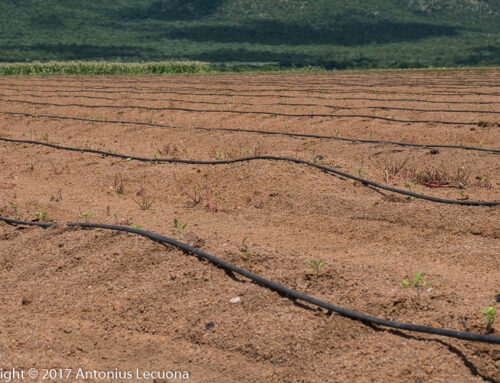Green bean soil cultivation for commercial small scale farmers
Green bean soil cultivation for commercial small scale farmers is also applied in large commercial farms. In a well prepared loose soil, bean roots can penetrate to a depth of 1200 mm. The effective root depth is 450 – 500 mm. Superficial green bean cultivation will limit the development of roots. It not only impedes root penetration and branching, but also reduces the plant’s resistance to drought and root diseases. Irrigating deeper than 500 mm is a waste and will increase irrigation cost.
It’s good practice to rip the soil with a ripper before planting. When the soil moisture content is suitable, the soil must be crumbled with a disc harrow or renovator to obtain the desired fine structure and an even surface. A pulverized condition is not desirable as it promotes crust formation and destroys soil structure. Soil structure is important for water percolation, aeration and permeability. So a structure-less soil will have much less drainage resulting in water logged conditions. The soil must be free of large clods and stones because they will not only interfere with planting and germination of seed, but will also cause problems when mechanical harvesters are used. Clods heat up more quickly and can interfere with the growth and development of small seedlings by changing the micro climate around it.
Rotovators tend to compact soil. It’s good practice to combine implements for best results and sustainable soil structure. If you have a home vegetable garden add dry organic matter or compost to the soil before loosening with a fork. It makes breaking clods easier.
If you suspect root knot nematodes, treat the 14 days before planting for best results. If you do not have access to fumigants I strongly recommend planting other plants that are resistant to nematodes.
Thorough preparation of the soil without making due allowance for the soil requirements of green beans, and without supplying enough of a well balanced fertilizer will not give maximum yields of good quality yields.
Planting Method
A great variety of planters are in use today. The modern tendency is to use precision planters, especially when mechanical harvesting is applied. Plant seed in moist or dry soil and follow by regular overhead irrigation until the seedlings emerge. A quick note on some sandy soils. Overhead sprinkler irrigation systems tend to create a crust on these soil types. Since green beans are very soft plants and the emerging hypocotyl and cotyledon is very soft, a crust will reduce emergence significantly.
Keep the following tips in mind when planting:
- Always try and plant seed at the same depth, not deeper than 50 mm (±2 inches). Seedlings will emerge simultaneously creating more uniform ripening and easier harvesting.
- Take care not to damage the seed during the planting process. Mechanical planters are prone to damage green bean seed.
- Green bean seed is very expensive, plant as accurately as possible with available resources. There is no magic in high planting densities. Higher than recommended planting density decreases marketable yields.
Green bean soil cultivation of soil after planting
The object of bean soil cultivation after the seeds have emerged is usually merely to control weeds and more than three hoe actions will never be necessary. However, to limit root damage to a minimum, these cultivation activities must be as shallow as possible. Stop mechanical cultivation as soon as the plants reach the stage when damage by implements is unavoidable. All woulds give entry to germs.
Disease enter damaged plant tissue and spread throughout the crop. Do not touch wet plants, rather wait until they are dry.
Cultivate between plants during the grown season to loosen the soil and increase water penetration, aeration and water holding capacity.

Green bean soil cultivation on a commercial scale. These beans will be mechanically harvested when ready.






Leave A Comment
You must be logged in to post a comment.